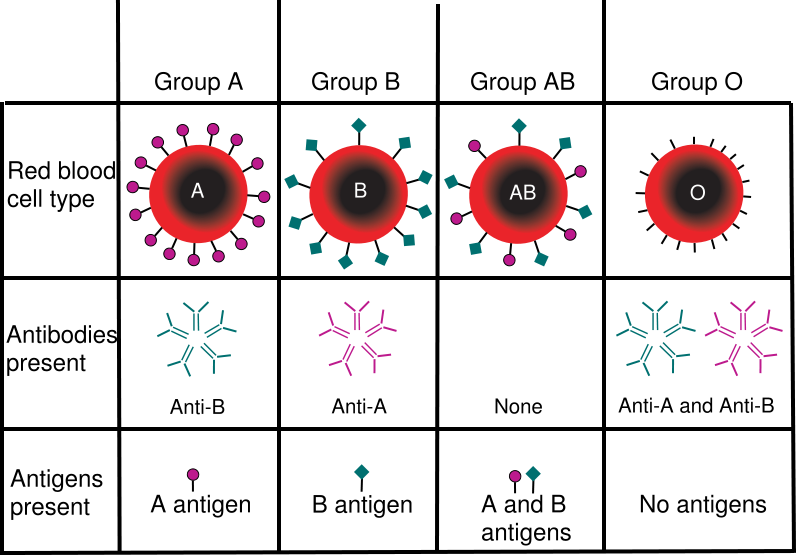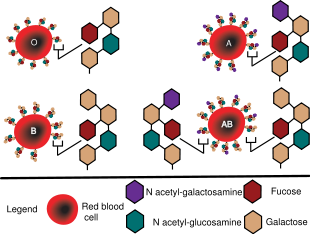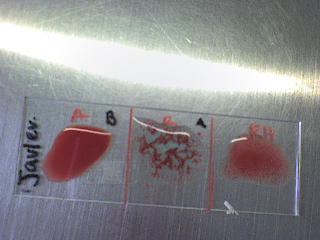ABO blood group system
Editor in Chief: Fumichiro Yamamoto, Ph.D. [1] Phone: 858-646-3116
Overview
The ABO blood group system is the most important blood type system (or blood group system) in human blood transfusion. The associated anti-A antibodies and anti-B antibodies are usually IgM antibodies, which are usually produced in the first years of life by sensitization to environmental substances such as food, bacteria and viruses. ABO blood types are also present in some animals, for example cows and sheep, apes such as chimpanzees, bonobos and gorillas.
ABO Antigens

The A and B antigens are derived from a common precursor known as the H antigen (or H substance). The H antigen is a carbohydrate sequence with carbohydrates linked mainly to proteins (with a minor fraction attached to ceramide moiety). The majority of the ABO determinants are expressed on the ends of long polylactosamine chains attached mainly to the Band 3 protein (1), the anion exchange protein of the red cell membrane. A minority of the epitopes are expressed on neutral glycosphingolipids (1). In blood group O the H antigen remains unchanged and consists of a chain of beta-D-galactose, beta-D-N-Acetylglucosamine, beta-D-galactose, and 2-linked, alpha-L-fucose. The chain is attached to the protein or ceramide. H antigens can be changed into A or B antigens by enzymes coded by the blood group A or B genes, which are sugar (glycosyl) tranferases. Type A has an extra alpha-N-Acetyl-D-galactosamine bonded to the D-galactose at the end, while type B has an extra alpha-D-galactose bonded to the D-galactose at the end.
- Individuals with Type A blood can receive blood from donors of type A and type O blood.
- Individuals with type B blood can receive blood from donors of type B and type O blood.
- Individuals with type AB blood can receive blood from donors of type A, type B, type AB, or type O blood. Type AB blood is referred to as the universal recipient.
- Individuals with of type O blood can only receive blood from type O donors.
- Individuals of type A, B, AB and O blood can receive blood from donors of type O blood. Type O blood is called the universal donor.
Antibodies are not formed against the H antigen, except by those with the Bombay phenotype.
In ABH secretors, ABH antigens are secreted by most mucus-producing cells of the body interfacing with the environment, including lung, skin, liver, pancreas, stomach, intestines, ovaries and prostate.[1]
History of discoveries
The ABO blood group system is widely credited to have been discovered by Austrian scientist Karl Landsteiner, who found three different blood types in 1900;[2] in 1930, he was awarded the Nobel Prize in Physiology or Medicine for his work. Due to inadequate communication at the time, it was subsequently found that Czech serologist Jan Janský had independently pioneered the classification of human blood into four groups,[3] but Landsteiner's independent discovery had been accepted by the scientific world while Janský remained in relative obscurity. Janský's classification is however still used both in Russia and in the states of the former U.S.S.R (see below). In the United States of America, Moss published his own (very similar) work in 1910.[4]
Several other landmark discoveries have been made in the ABO blood type rsearch in the past century. As described above, Landsteiner described A, B, and O in his research; Decastrello and Sturli discovered the fourth ABO blood type, AB, in 1902.[5] Ludwik Hirszfeld and E. von Dungern discovered the heritability of ABO blood groups in 1910-11, with Felix Bernstein demonstrating the correct blood group inheritance pattern of multiple alleles at one locus in 1924. [6]. Watkins and Morgan, in England, determined that ABO epitopes were conferred by sugars, specifically N-acetylgalactosamine for the A-type and galactose for the B-type (Morgan, W. T. J. & Watkins, W. M. Br. Med. Bull. 25, 30−34 (1969), Watkins, W. M. in: Advances in Human Genetics Vol. 10 (eds Harris, H. & Hirschhorn, K.) 1−136 (Plenum, New York, 1980), Watkins, W. M. & Morgan, W. T. J. Vox Sang. 4, 97−119 (1959). After much published literature claiming that the ABH substances were all attached to glycosphingolipids, Laine's group (1988) found that the band 3 protein expressed a long polylactosamine chain (Jarnefelt, Rush, Li, Laine, J. Biol. Chem. 253: 8006-8009(1978)) which contained the major portion of the ABH substances attached (Laine and Rush in Molecular Immunology of Complex Carbohydrates (A. Wu, E. Kabat, Eds.) Plenum Publishing Corporation, N.Y. NY (1988)). Later, Yamamoto, Clausen, and Hakomori (Yamamoto, et al.,Nature 345, 229 - 233 (1990)), showed the precise glycosyl transferase set that confers the A, B and O epitopes.
Serology

Anti-A and anti-B antibodies, which are not present in the newborns, appear in the first years of life. It is possible that food and environmental antigens (bacterial, viral or plant antigens) are similar enough to A and B glycoprotein antigens that antibodies created against the environmental antigens in the first years of life can cross react with ABO-incompatible red blood cells. Anti-A and anti-B antibodies are usually IgM, antibodies that are not able to pass through the placenta to fetal blood circulation.
When budding viruses take host cell membranes from a human patient (in particular from the lung and mucosal epithelia, where they are highly expressed), they also acquire ABO blood antigens from those membranes. As such, these viruses may carry the antigens into secondary recipients where they can elicit a host immune response. These viral-carried human-blood antigens may be responsible for priming newborns into producing neutralizing antibodies against foreign blood antigens. Support for this theory, named later as the "Light in the Dark theory" (DelNagro, 1998), has had particular application in experiments with HIV. HIV can be neutralized in "in vitro" experiments using antibodies against blood group antigens specifically expressed on the HIV producing cell lines. [7] [8]
The "Light in the Dark theory" suggests a new novel evolutionary hypothesis, namely that there is true communal immunity that has developed to reduce the inter-transmissibility of viruses within a population. It suggests that individuals in a population both produce and supply a diversity of unique antigenic moieties so as to keep the overall population more resistant to infection. This system is ideally set up to work with variable recessive alleles.
ABO hemolytic disease of the newborn
ABO blood group incompatibilities between mother and child do not usually cause hemolytic disease of the newborn (HDN), because antibodies to ABO blood groups are usually of the IgM type, which do not cross the placenta; however, sometimes IgG ABO antibodies are produced and a baby can develop ABO hemolytic disease of the newborn.
Inheritance

| Blood group inheritance | ||||
| Mother/Father | O | A | B | AB |
|---|---|---|---|---|
| O | O | O, A | O, B | A, B |
| A | O, A | O, A | O, A, B, AB | A, B, AB |
| B | O, B | O, A, B, AB | O, B | A, B, AB |
| AB | A, B | A, B, AB | A, B, AB | A, B, AB |
Blood groups are inherited from both parents. The ABO blood type is controlled by a single gene with three alleles: A, B, and O. The gene encodes a glycosyltransferase - that is, an enzyme that modifies the carbohydrate content of the red blood cell antigens. The gene is located on the long arm of the ninth chromosome (9q34).
A allele gives type A, B gives type B, and O gives type O. A and B are dominant over O, so OO people have type O, AA or AO have A, and BB or BO have type B. AB people have both phenotypes because A and B express a special dominance relationship: codominance, which means that type A and B parents can have an AB child. A type A and a type B couple can also have a type O child if they are both heterozygous (AO and BO) Therefore, in this case, a child with blood type O is not direct proof of illegitimacy. The cis-AB phenotype has a single enzyme that creates both A and B antigens. The resulting red blood cells do not usually express A or B antigens at the same level that would be expected on common group A1 or B red blood cells. This distinction can help solve the problem of an apparently genetically impossible blood group.[9]
One prominent theory suggests that type O evolved earliest, supported by the fact that all human beings can receive type O blood. The British National Blood Transfusion Service supports this theory (see the web-link under External Links below) and states that originally, all human beings were type O. However, based on results obtained using the modern genetic method, some evolutionary biologists theorize that the A allele evolved first, followed by O (O being formed by the deletion of a single nucleotide, which shifts the reading frame), and then B. This chronology accounts for the percentage of people worldwide with each blood type. This more recent theory is also consistent with accepted patterns of early population movements and varying prevalent blood types in different parts of the world. For instance, type B is very common in populations of Asian descent, but rare in ones of Western European descent.
Population data
The distribution of the blood groups A, B, O and AB varies across the world according to the population. There are also variations in blood type distribution within human subpopulations.
In the UK the distribution of blood type frequencies throughout the population still shows some correlation both to the distribution of placenames and to the successive invasions and migrations (including Vikings, Danes, Saxons, Celts, and Normans) that contributed the morphemes and genes to the population.[10]
There are six common alleles that produce one's blood type:[11][12]
Many rare variants of these alleles have been found in human populations around the world. Association with von Willebrand factorThe ABO antigen is also expressed on the von Willebrand factor (vWF) glycoprotein,[13] which participates in hemostasis (control of bleeding). In fact, having type O blood predisposes someone to bleeding,[14] as 30% of the total genetic variation observed in plasma vWF is explained by the effect of the ABO blood group,[15] and individuals with group O blood normally have significantly lower plasma levels of vWF (and Factor VIII) than do non-O individuals.[16][17] In addition, vWF is degraded more rapidly due to the higher prevalence of blood group O with the Cys1584 variant of vWF (an amino acid polymorphism in VWF):[18] the gene for ADAMTS13 (vWF-cleaving protease) maps to the ninth chromosome (9q34), the same locus as ABO blood type. Higher levels of vWF are more common amongst people who have had an ischaemic stroke (from blood clotting) for the first time.[19] The results of this study found that occurrence was not affected by ADAMTS13 polymorphism, and the only significant genetic factor was the person's blood group. Bombay phenotypeIndividuals with the rare Bombay phenotype (hh) do not express substance H on their red blood cells, and therefore do not bind A or B antigens. Instead, they produce antibodies to substance H (which is present on all red cells except those of the hh genotype) as well as to both A and B antigens, and can therefore receive blood only from other hh donors (although they can donate as though they were type O). Nomenclature in Europe and former USSRIn parts of Europe the "O" in ABO blood type is substituted with the numeral "0" (zero), signifying the lack of A or B antigens. In the former U.S.S.R blood types are referenced using numbers and Roman numerals instead of letters. This is Janský's original classification, which designates the blood types of humans as I, II, III, and IV, elsewhere designated, respectively, as O, A, B, and AB.[20] The designation of A and B with reference to blood groups was proposed by Ludwik Hirszfeld. Examples of ABO and Rhesus D slide testing method
In the slide testing method shown above, three drops of blood are placed on a glass slide with liquid reagents. Agglutination indicates the presence of blood group antigens in the blood. Universal blood created from other types, and artificial bloodIn April 2007 an international team of researchers announced in the journal Nature Biotechnology an inexpensive and efficient way to convert types A, B and AB blood into type O. [21] This conversion is done by using glycosidase enzymes from specific bacteria to strip the blood group antigens from red blood cells. The removal of A and B antigens still does not address the problem of the Rhesus blood group antigen on the blood cells of Rhesus positive individuals, and so blood from Rhesus negative donors must be used. Patient trials will be conducted before the method can be relied on in live situations. Another approach to the blood antigen problem is the creation of artificial blood, which could act as a substitute in emergencies. BBC. MythsThere are numerous popular myths surrounding ABO blood groups. These beliefs have existed since ABO blood groups were identified and can be found in different cultures throughout the world. For example, during the 1930s, connecting blood groups to personality types became popular in Japan and other areas of the world.[22] The popularity of Peter J. D'Adamo's book, Eat Right For Your Blood Type suggests that these myths persist. This book claims that ABO blood groups can be used to determine diet as well as to predict diseases. Additional myths include the idea that Group A causes severe hangovers, group O is associated with perfect teeth, and those with blood group A2 have the highest IQs. Scientific evidence in support of these concepts is scant or nonexistent.[23] References
Further reading
External links
da:AB0 de:AB0-System dv:އޭބީއޯ ލޭގެ ގުރޫޕްގެ ނިޒާމް et:AB0-süsteem gl:Sistema AB0 is:ABO-blóðflokkar |

